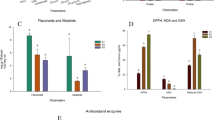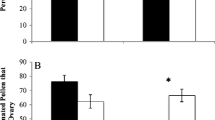Abstract
Background and aims
Noccaea caerulescens is a model plant for understanding metal hyperaccumulation as well as being a potential source of cultivars for phytoextraction. Sixty populations from non-metallicolous (NM), calamine (CAL) and serpentine (SER) edaphic groups were phenotyped in order to more extensively characterise the species and to detect candidates for cultivar selection.
Methods
15 plants per population were grown until fruit maturity in a greenhouse on a homogeneous soil spiked with Cd, Ni and Zn. Development, growth and ionome variables were measured.
Results
NM and SER edaphic groups seem to be similar, with plants producing fewer inflorescences and shoot biomass, flowering later, reaching maturity sooner and accumulating more transition metals than CAL plants. Three geographically structured CAL subgroups could be distinguished according to their shoot Cd/Zn ratio. Only CAL populations from the south east of the Massif Central were observed to hyperaccumulate Cd. At the species level, the Ni and Zn contents were strongly correlated. Nickel accumulation was also closely associated to that of Mg and Ca. The NM and SER edaphic groups both hyperaccumulated Ni and Zn. Biomass production was not correlated to metal contents, suggesting no trade-off between these traits.
Conclusions
The high natural variability of N. caerulescens’ traits and its accumulation potential could be exploited for the production of phytoextraction cultivars.








Similar content being viewed by others
References
Adler D (2005) vioplot: Violin Plot. R package version 0.2. http://CRAN.R-project.org/package=vioplot
Assunção AGL, Martins PDC, De Folter S, Vooijs R, Schat H, Aarts MGM (2001) Elevated expression of metal transporter genes in three accessions of the metal hyperaccumulator Thlaspi caerulescens. Plant Cell Environ 24:217–226. doi:10.1111/j.1365-3040.2001.00666.x
Assunção AGL, Bookum WM, Nelissen HJM, Vooijs R, Schat H, Ernst WHO (2003a) Differential metal-specific tolerance and accumulation patterns among Thlaspi caerulescens populations originating from different soil types. New Phytol 159:411–419
Assunção AGL, Schat H, Aarts MGM (2003b) Thlaspi caerulescens, an attractive model species to study heavy metal hyperaccumulation in plants. New Phytol 159:351–360
Baker AJM, Reeves RD, Hajar ASM (1994) Heavy metal accumulation and tolerance in British populations of the metallophyte Thlaspi caerulescens J. & C. Presl (Brassicaceae). New Phytol 127:61–68. doi:10.1111/j.1469-8137.1994.tb04259.x
Banásová V, Horak O, Nadubinská M, Čiamporová M, Lichtscheidl I (2008) Heavy metal content in Thlaspi caerulescens J. et C. Presl growing on metalliferous and non-metalliferous soils in Central Slovakia. Int J Environ Pollut 33:133–145
Bani A, Echevarria G, Sulçe S, Morel JL (2015) Improving the agronomy of Alyssum murale for extensive phytomining: a five-year field study. Int J Phytoremediation 17:117–127. doi:10.1080/15226514.2013.862204
Barbaroux R, Mercier G, Blais JF, Morel JL, Simonnot MO (2011) A new method for obtaining nickel metal from the hyperaccumulator plant Alyssum murale. Sep Purif Technol 83:57–65
Basic N, Keller C, Fontanillas P, Vittoz P, Besnard G, Galland N (2006) Cadmium hyperaccumulation and reproductive traits in natural Thlaspi caerulescens populations. Plant Biol:64–72
Brachi B, Villoutreix R, Faure N, Hautekèete N, Piquot Y, Pauwels M, Roby D, Cuguen J, Bergelson J, Roux F (2013) Investigation of the geographical scale of adaptive phenological variation and its underlying genetics in Arabidopsis thaliana. Mol Ecol 22:4222–4240. doi:10.1111/mec.12396
Brown SL, Angle JS, Chaney RL, Baker AJM (1995) Zinc and cadmium uptake by hyperaccumulator Thlaspi caerulescens grown in nutrient solution. Soil Sci Soc Am J 59:125–133. doi:10.2136/sssaj1995.03615995005900010020x
Chardot V, Echevarria G, Gury M, Massoura S, Morel J (2007) Nickel bioavailability in an ultramafic toposequence in the Vosges Mountains (France). Plant Soil 293:7–21
Clemens S (2006) Toxic metal accumulation, responses to exposure and mechanisms of tolerance in plants. Biochimie 88:1707–1719
Dechamps C, Roosens NH, Cl H, Meerts P (2005) Growth and mineral element composition in two ecotypes of Thlaspi caerulescens on cd contaminated soil. Plant Soil 273:327–335
Dechamps C, Elvinger N, Meerts P, Lefèbvre C, Escarré J, Colling G, Noret N (2011) Life history traits of the pseudometallophyte Thlaspi caerulescens in natural populations from northern Europe. Plant Biol 13:125–135
Deng T-H-B, Cloquet C, Tang Y-T, Sterckeman T, Echevarria G, Estrade N, Morel J-L, Qiu R-L (2014) Nickel and zinc isotope fractionation in hyperaccumulating and nonaccumulating plants. Environ Sci Technol 48:11926–11933. doi:10.1021/es5020955
van der Ent A, Baker AJM, Reeves RD, Pollard AJ, Schat H (2013) Hyperaccumulators of metal and metalloid trace elements: facts and fiction. Plant Soil 362:319–334
Escande V, Olszewski TK, Grison C (2014) Preparation of ecological catalysts derived from Zn hyperaccumulating plants and their catalytic activity in Diels–Alder reaction. C R Chim 17:731–737. doi:10.1016/j.crci.2013.09.009
Escarré J, Lefèbvre C, Gruber W, Leblanc M, Lepart J, Rivière Y, Delay B (2000) Zinc and cadmium hyperaccumulation by Thlaspi caerulescens from metalliferous and nonmetalliferous sites in the Mediterranean area: implications for phytoremediation. New Phytol 145:429–437. doi:10.1046/j.1469-8137.2000.00599.x
Escarré J, Lefèbvre C, Frérot H, Mahieu S, Noret N (2013) Metal concentration and metal mass of metallicolous, non metallicolous and serpentine Noccaea Caerulescens populations, cultivated in different growth media. Plant Soil 370:197–221. doi:10.1007/s11104-013-1618-z
Frérot H, Lefebvre C, Petit C, Collin C, Dos Santos A, Escarre J (2005) Zinc tolerance and hyperaccumulation in F1 and F2 offspring from intra and interecotype crosses of Thlaspi caerulescens. New Phytol 165:111–119
Gebert M, Meschenmoser K, Svidová S, Weghuber J, Schweyen R, Eifler K, Lenz H, Weyand K, Knoop V (2009) A root-expressed magnesium transporter of the MRS2/MGT gene family in Arabidopsis thaliana allows for growth in low-Mg2+ environments. Plant Cell 21:4018–4030. doi:10.1105/tpc.109.070557
Gonneau C (2014) Distribution, écologie et évolution de l’hyperaccumulation des éléments en traces par Noccaea caerulescens. École Doctorale « Ressources Procédés Produits Environnement ». Université de Lorraine.
Gonneau C, Genevois N, Frérot H, Sirguey C, Sterckeman T (2014) Variation of trace metal accumulation, major nutrient uptake and growth parameters and their correlations in 22 populations of Noccaea caerulescens. Plant Soil 384:271–287. doi:10.1007/s11104-014-2208-4
Gonneau C, Noret N, Godé C, Frérot H, Sirguey C, Sterckeman T, Pauwels M (2017) Demographic history of the trace metal hyperaccumulator Noccaea caerulescens (J. Presl and C. Presl) F. K. Mey. in Western Europe. Mol Ecol 29:904–922
Halimaa P, Lin Y-F, Ahonen VH, Blande D, Clemens S, Gyenesei A, Häikiö E, Kärenlampi SO, Laiho A, Aarts MGM, Pursiheimo J-P, Schat H, Schmidt H, Tuomainen MH, Tervahauta AI (2014) Gene expression differences between Noccaea caerulescens ecotypes help to identify candidate genes for metal phytoremediation. Environ Sci Technol 48:3344–3353. doi:10.1021/es4042995
Hammer D, Keller C (2003) Phytoextraction of cd and Zn with Thlaspi caerulescens in field trials. Soil Use Manage 19:144–149. doi:10.1111/j.1475-2743.2003.tb00295.x
Jimenez-Ambriz G, Petit C, Bourrie I, Dubois S, Olivieri I, Ronce O (2007) Life history variation in the heavy metal tolerant plant Thlaspi Caerulescens growing in a network of contaminated and noncontaminated sites in southern France: role of gene flow, selection and phenotypic plasticity. New Phytol 173:199–215. doi:10.1111/j.1469-8137.2006.01923.x
Keller C, Diallo S, Cosio C, Basic N, Galland N (2006) Cadmium tolerance and hyperaccumulation by Thlaspi caerulescens populations grown in hydroponics are related to plant uptake characteristics in the field. Funct Plant Biol 33:673–684. doi:10.1071/FP05217
Koch MA, German D (2013) Taxonomy and systematics are key to biological information: Arabidopsis, Eutrema (Thellungiella), Noccaea and Schrenkiella (Brassicaceae) as examples. Front Plant Sci 4. doi:10.3389/fpls.2013.00267
Koopmans GF, Römkens PFAM, Fokkema MJ, Song J, Luo YM, Japenga J, Zhao FJ (2008) Feasibility of phytoextraction to remediate cadmium and zinc contaminated soils. Environ Pollut 156:905–914
Lebreton J-D, Klein E, Gimenez O, Rousset F (2009) Statistiques pour la biologie évolutive. In: Thomas F, Lefevre T, Raymond M (eds) Biologie évolutive. De Boeck, Bruxelles
Li MY, Chaney R, Brewer E, Roseberg R, Angle JS, Baker A, Reeves R, Nelkin J (2003) Development of a technology for commercial phytoextraction of nickel: economic and technical considerations. Plant Soil V249:107–115
Lombi E, Zhao FJ, McGrath SP, Young SD, Sacchi GE (2001) Physiological evidence for a high-affinity cadmium transporter highly expressed in a Thlaspi caerulescens ecotype. New Phytol 149:53–60
Lombi E, Tearall KL, Howarth JR, Zhao F-J, Hawkesford MJ, McGrath SP (2002) Influence of iron status on cadmium and zinc uptake by different ecotypes of the hyperaccumulator Thlaspi caerulescens. Plant Physiol 128:1359–1367
Lovy L (2012) Hyperaccumulation du Cd par Noccaea caerulescens: cinétique, répartition et prédiction. Ecole Doctorale Ressources, Procédés, Produits et Environnement. Université de Lorraine, Vandoeuvre-lès-Nancy.
Lovy L, Latt D, Sterckeman T (2013) Cadmium uptake and partitioning in the hyperaccumulator Noccaea caerulescens exposed to constant cd concentrations throughout complete growth cycles. Plant soil: 345–354.
Maathuis FJ (2007) Transport across plant membranes. In: Yeo AR, Flowers TJ (eds) Plant solute transport. Blackwell Publishing, Oxford
Maechler M (2015) diptest: Hartigan's dip test statistic for unimodality – Corrected. R Package Version 0.75–7.
Maxted AP, Black CR, West HM, Crout NMJ, McGrath SP, Young SD (2007) Phytoextraction of cadmium and zinc from arable soils amended with sewage sludge using Thlaspi caerulescens: development of a predictive model. Environ Pollut 150:363–372
McGrath SP, Lombi E, Gray CW, Caille N, Dunham SJ, Zhao FJ (2006) Field evaluation of cd and Zn phytoextraction potential by the hyperaccumulators Thlaspi caerulescens and Arabidopsis halleri. Environ Pollut 141:115–125
Meerts P, Van Isacker N (1997) Heavy metal tolerance and accumulation in metallicolous and non-metallicolous populations of Thlaspi caerulescens from continental Europe. Plant Ecol 133:221–231. doi:10.1023/a:1009717619579
Milner MJ, Kochian LV (2008) Investigating heavy-metal hyperaccumulation using Thlaspi caerulescens as a model system. Ann Bot 102:3–13. doi:10.1093/aob/mcn063
Milner MJ, Mitani-Ueno N, Yamaji N, Yokosho K, Craft E, Fei Z, Ebbs S, Zambrano MC, Ma JF, Kochian LV (2014) Root and shoot transcriptome analysis of two ecotypes of Noccaea caerulescens uncovers the role of NcNramp1 in cd hyperaccumulation. Plant J 78:398–410. doi:10.1111/tpj.12480
Molitor M, Dechamps C, Gruber W, Meerts P (2005) Thlaspi caerulescens on nonmetalliferous soil in Luxembourg: ecological niche and genetic variation in mineral element composition. New Phytol 165:503–512
Rees F (2014) Mobilité des métaux dans les systèmes sol-plante-biochar. Université de Lorraine
Reeves RD, Schwartz C, Morel JL, Edmondson J (2001) Distribution and metal-accumulating behavior of Thlaspi caerulescens and associated metallophytes in France. Int J Phytoremediation 3:145–172
Schock I, Gregan J, Steinhauser S, Schweyen R, Brennicke A, Knoop V (2000) A member of a novel Arabidopsis thaliana gene family of candidate Mg2+ ion transporters complements a yeast mitochondrial group II intron-splicing mutant. Plant J 24:489–501. doi:10.1111/j.1365-313X.2000.00895.x
Schwartz C, Echevarria G, Morel JL (2003) Phytoextraction of cadmium with Thlaspi caerulescens. Plant Soil 249:27–35
Verbruggen N, Hermans C, Schat H (2009) Molecular mechanisms of metal hyperaccumulation in plants. New Phytol 181:759–776
Visioli G, Vincenzi S, Marmiroli M, Marmiroli N (2012) Correlation between phenotype and proteome in the Ni hyperaccumulator Noccaea Caerulescens subsp. caerulescens. Environ Exp Bot 77:156–164
Welch RM, Norvell WA (1999) Mechanisms of cadmium uptake, translocation and deposition in plants. In: McLaughlin MJ, Singh BR (eds) Cadmium in soils and plants. Kluwer Academic Publishers, Dordrecht
Zhao F-J, Hamon RE, Lombi E, McLaughlin MJ, McGrath SP (2002) Characteristics of cadmium uptake in two contrasting ecotypes of the hyperaccumulator Thlaspi caerulescens. J Exp Bot 53:535–543
Zhao FJ, Lombi E, McGrath SP (2003) Assessing the potential for zinc and cadmium phytoremediation with the hyperaccumulator Thlaspi caerulescens. Plant Soil 249:37–43
Acknowledgements
The authors thank the Région Lorraine and the FEDER (European Union) for funding this research carried out within the framework of the LORVER project set up by Jean-Louis Morel and coordinated by Sophie Guimont and Marie-Odile Simonnot. They are grateful to Stéphane Colin, Jean-Claude Bégin, Christophe Bailly and Adeline Motz for their technical help and to Philippe Antonetti (National Botanical Conservatory from the Massif Central), Olivier Bardet (National Botanical Conservatory from the Bassin Parisien), Yoric Ferrez (National Botanical Conservatory from Franche Comté), Thierry Mahevas and Guy Seznec (Nancy Conservatory and Botanical Gardens) for their help in locating the N. caerulescens populations. The authors also thank Mark Aarts, Guillaume Besnard, José Escarré, Hélène Frérot, Markus Koch, Nausicaa Noret, Maxime Pauwels for providing N. caerulescens seeds. They are grateful to Maxime Pauwels for his advice on the manuscript.
Author information
Authors and Affiliations
Corresponding author
Additional information
Responsible Editor: Henk Schat.
Electronic supplementary material
ESM
(XLSX 696 kb)
Rights and permissions
About this article
Cite this article
Sterckeman, T., Cazes, Y., Gonneau, C. et al. Phenotyping 60 populations of Noccaea caerulescens provides a broader knowledge of variation in traits of interest for phytoextraction. Plant Soil 418, 523–540 (2017). https://doi.org/10.1007/s11104-017-3311-0
Received:
Accepted:
Published:
Issue Date:
DOI: https://doi.org/10.1007/s11104-017-3311-0




